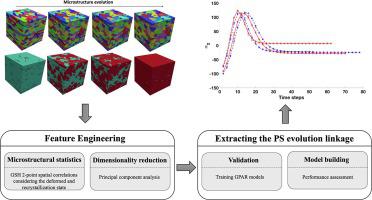当前位置:
X-MOL 学术
›
Comp. Mater. Sci.
›
论文详情
Our official English website, www.x-mol.net, welcomes your
feedback! (Note: you will need to create a separate account there.)
A machine learning framework for the temporal evolution of microstructure during static recrystallization of polycrystalline materials simulated by cellular automaton
Computational Materials Science ( IF 3.1 ) Pub Date : 2021-02-01 , DOI: 10.1016/j.commatsci.2020.110132 Sepideh Hashemi , Surya R. Kalidindi
Computational Materials Science ( IF 3.1 ) Pub Date : 2021-02-01 , DOI: 10.1016/j.commatsci.2020.110132 Sepideh Hashemi , Surya R. Kalidindi

|
Abstract Reduced-order models of process-structure evolution linkages play a central role in the discovery and development of new/improved materials and their deployment in advanced technologies. In this paper, a novel machine learning framework is developed for capturing the temporal evolution of microstructures during static recrystallization of face-centered cubic (FCC) polycrystalline materials and is demonstrated on a collection of simulation data produced using cellular automata. This new framework first establishes a suitable low-dimensional representation of the polycrystalline microstructures based on 2-point spatial correlations expressed in a generalized spherical harmonics (GSH) basis. Second, a Gaussian process autoregression (GPAR) time-series modeling approach is employed to establish the desired reduced-order process-structure evolution model. It is demonstrated that the framework presented in this paper produces remarkably accurate and robust reduced-order models for the problem studied, in spite of the highly complex three-dimensional (3-D) microstructures involved.
中文翻译:

元胞自动机模拟多晶材料静态再结晶过程中微观结构时间演化的机器学习框架
摘要 过程-结构演化联系的降阶模型在新/改进材料的发现和开发及其在先进技术中的部署中发挥着核心作用。在本文中,开发了一种新的机器学习框架,用于捕捉面心立方 (FCC) 多晶材料静态再结晶过程中微观结构的时间演变,并在使用元胞自动机生成的一组模拟数据上进行了演示。这种新框架首先基于广义球谐函数 (GSH) 基础上表示的 2 点空间相关性,建立了多晶微结构的合适低维表示。第二,采用高斯过程自回归 (GPAR) 时间序列建模方法来建立所需的降阶过程结构演化模型。事实证明,尽管涉及高度复杂的三维 (3-D) 微观结构,但本文中提出的框架为所研究的问题生成了非常准确和稳健的降阶模型。
更新日期:2021-02-01
中文翻译:

元胞自动机模拟多晶材料静态再结晶过程中微观结构时间演化的机器学习框架
摘要 过程-结构演化联系的降阶模型在新/改进材料的发现和开发及其在先进技术中的部署中发挥着核心作用。在本文中,开发了一种新的机器学习框架,用于捕捉面心立方 (FCC) 多晶材料静态再结晶过程中微观结构的时间演变,并在使用元胞自动机生成的一组模拟数据上进行了演示。这种新框架首先基于广义球谐函数 (GSH) 基础上表示的 2 点空间相关性,建立了多晶微结构的合适低维表示。第二,采用高斯过程自回归 (GPAR) 时间序列建模方法来建立所需的降阶过程结构演化模型。事实证明,尽管涉及高度复杂的三维 (3-D) 微观结构,但本文中提出的框架为所研究的问题生成了非常准确和稳健的降阶模型。











































 京公网安备 11010802027423号
京公网安备 11010802027423号